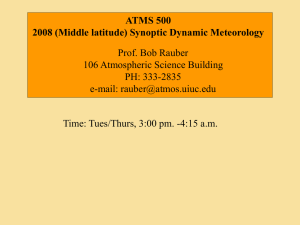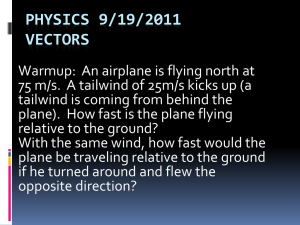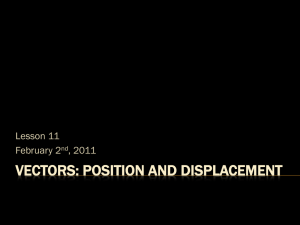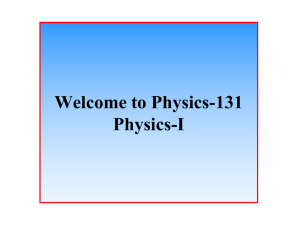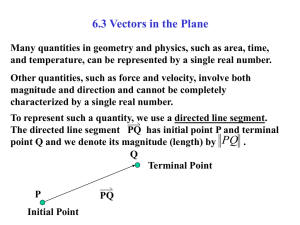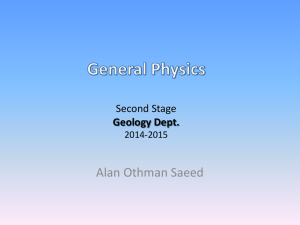Physics - The Mathematics of Basic Physics
advertisement
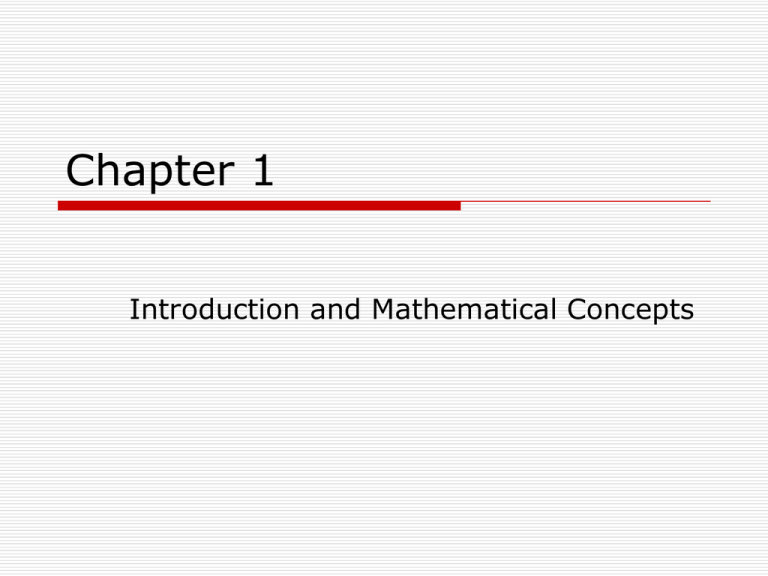
Chapter 1 Introduction and Mathematical Concepts Table of Contents 1. 2. 3. 4. 5. 6. 7. 8. 9. The Nature of Physics Units Role of Units in Problem Solving Trigonometry Scalars and Vectors Vector Addition and Subtraction Components of a Vector Addition of Vectors by Means of Components Other Stuff Chapter 1: Introduction and Mathematical Concepts Section 1 – The Nature of Physics What is Physics? The “Fundamental Science” Study of matter and how it moves through space-time Applications of concepts such as Energy, and Force The general analysis of the natural world “understand” and predict how our universe behaves Chapter 1: Introduction and Mathematical Concepts Section 2 - Units Units To “understand” nature, we must first study what it does Must have/use a universal way of describing what nature does Systems of measurement “British” (American) Metric SI Base Units Most fundament forms of measurement Mass – kilogram (kg) Length – meter (m) Time – second (s) Count – mole (mol) Temperature – kelvin (K) Current – ampere (A) Luminous Intensity – candela (cd) SI Features Derived Units Common combinations of base units e.g.: area, force, pressure Prefixes Adjust scale of measurement Metric – powers of 10 SI – powers of 1000 SI Prefixes 1024 yotta (Y) 1021 zetta (Z) 1018 exa (E) 1015 peta (P) 1012 tera (T) 109 giga (G) 106 mega (M) 103 kilo (k) 10-3 milli (m) 10-6 micro (µ) 10-9 nano (n) 10-12 pico (p) 10-15 femto (f) 10-18 atto (a) 10-21 zepto (z) 10-24 yocto (y) Chapter 1: Introduction and Mathematical Concepts Section 3 The Role of Units in Problem Solving Conversion of Units Remember from algebra… Multiplying by 1 does not change number If 1 m = 1000 mm, then 1 m/1000 mm = 1 Question #1 When we measure physical quantities, the units may be anything that is reasonable as long as they are well defined. It’s usually best to use the international standard units. Density may be defined as the mass of an object divided by its volume. Which of the following units would probably not be acceptable units of density? a)gallons/liter b)kilograms/m3 c)pounds/ft3 d)slugs/yd3 e)grams/milliliter Question #2 A car starts from rest on a circular track with a radius of 150 m. Relative to the starting position, what angle has the car swept out when it has traveled 150 m along the circular track? a) 1 radian b) /2 radians c) radians d) 3/2 radians e) 2 radians Question #3 A section of a river can be approximated as a rectangle that is 48 m wide and 172 m long. Express the area of this river in square kilometers. a) 8.26 × 103 km2 c) 8.26 × 103 km2 e) 3.58 × 102 km2 b) 8.26 km2 d) 3.58 km2 Question #4 If one inch is equal to 2.54 cm, express 9.68 inches in meters. a) 0.262 m c) 0.0508 m e) 0.246 m b) 0.0381 m d) 0.114 m Dimensional Analysis When in doubt, look at the units Since units are part of the number, units must balance out for a valid equation By analyzing the units, you can determine if your solution is correct. If the units from your calculation do not give you the units you need, you have an error Example DIMENSIONAL ANALYSIS [L] = length [M] = mass [T] = time Is the following equation dimensionally correct? 2 1 2 x vt L 2 L T LT T Question #5 Using the dimensions given for the variables in the table, determine which one of the following expressions is correct. g a) f 2 l b) c) d) f 2l g 2 f g l 2 f l g e) f 2 gl Question #6 Given the following equation: y = cnat2, where n is an integer with no units, c is a number between zero and one with no units, the variable t has units of seconds and y is expressed in meters, determine which of the following statements is true. a) a has units of m/s and n =1. b) a has units of m/s and n =2. c) a has units of m/s2 and n =1. d) a has units of m/s2 and n =2. e) a has units of m/s2, but value of n cannot be determined through dimensional analysis. Question #7 Approximately how many seconds are there in a century? a) 86,400 s b) 5.0 × 106 s c) 3.3 × 1018 s d) 3.2 × 109 s e) 8.6 × 104 s Chapter 1: Introduction and Mathematical Concepts Section 4 - Trigonometry Basics you should remember… ho sin h ha cos h ho tan ha Basics you should remember… ho sin h 1 ha cos h 1 ho tan ha 1 h h h 2 2 o 2 a Question #8 Determine the angle in the right triangle shown. a) 54.5 b) 62.0 c) 35.5 d) 28.0 e) 41.3 Question #9 Determine the length of the side of the right triangle labeled x. a) 2.22 m b) 1.73 m c) 1.80 m d) 2.14 m e) 1.95 m Question #10 Determine the length of the side of the right triangle labeled x. a) 0.79 km b) 0.93 km c) 1.51 km d) 1.77 km e) 2.83 km Chapter 1: Introduction and Mathematical Concepts Section 5 – Scalar & Vectors Scalar & Vector A scalar quantity is one that can be described by a single number: temperature, speed, mass A vector quantity deals inherently with both magnitude and direction: velocity, force, displacement More on Vectors Arrows are used to represent vectors. The direction of the arrow gives the direction of the vector. By convention, the length of a vector arrow is proportional to the magnitude of the vector. 8 lb 4 lb Question #11 Which one of the following statements is true concerning scalar quantities? a) Scalar quantities must be represented by base units. b) Scalar quantities have both magnitude and direction. c) Scalar quantities can be added to vector quantities using rules of trigonometry. d) Scalar quantities can be added to other scalar quantities using rules of trigonometry. e) Scalar quantities can be added to other scalar quantities using rules of ordinary addition. Chapter 1: Introduction and Mathematical Concepts Section 6 Vector Addition and Subtraction Graphical Addition of vectors Remember length of arrow is proportional to magnitude Angle of arrow proportional to direction Place tail of 2nd vector at tip of 1st Resultant starts at 1st and ends at 2nd AB R R A B Graphical Subtraction of Vectors Same as addition, multiply value by (-1) Resultant is still tail to tip AB R A R B -B Question #12 Which expression is false concerning the vectors shown in the sketch? a) C A B b) A B C 0 c) C A B d) C <A+B e) A2 + B2 = C2 Chapter 1: Introduction and Mathematical Concepts Section 7 Components of a Vector Vector Component T hevectorcomponentsof A are two perpendicular vectorsA x and A y thatare parallelto the x and y axes, and add togethervectorially so thatA A x A y . Scalar Components It is often easier to work with the scalar components rather than the vector components. Ax and Ay are thescalar components of A. xˆ and yˆ are unit vectors with magnitude1. A Ax xˆ Ay yˆ In math, they are called i and j Example Problem A displacement vector has a magnitude of 175 m and points at an angle of 50.0 degrees relative to the x axis. Find the x and y components of this vector. cos x r sin y r y r sin 175msin 50.0 134m x r cos 175m cos50.0 112m r 112mxˆ 134myˆ Question #13 During the execution of a play, a football player carries the ball for a distance of 33 m in the direction 76° north of east. To determine the number of meters gained on the play, find the northward component of the ball’s displacement. a) 8.0 m b) 16 m c) 24 m d) 28 m e) 32 m Question #14 Vector a has components ax = 15.0 and ay = 9.0. What is the approximate magnitude of vector ? a) 12.0 b) 24.0 c) 10.9 d) 6.87 e) 17.5 Question #15 Vector a has a horizontal component ax = 15.0 m and makes an angle = 38.0 with respect to the positive x direction. What is the magnitude of ay, the vertical component of vector ? a) 4.46 m b) 11.7 m c) 5.02 m d) 7.97 m e) 14.3 m Chapter 1: Introduction and Mathematical Concepts Section 8 Addition of Vectors by Means of Components Addition using components C A B Ay Ax C AB A Ax xˆ Ay yˆ B Bx xˆ By yˆ By C By Bx Ay Ax Bx C Ax xˆ Ay yˆ Bx xˆ B y yˆ Ax Bx xˆ Ay B y yˆ Cx Ax Bx Cy Ay By Quesiton #16,17 The drawing above shows two vectors A and B, and the drawing on the right shows their components. Each of the angles θ = 31°. When the vectors A and B are added, the resultant vector is R, so that R = A + B. What are the values for Rx and Ry, the xand y-components of R? Rx = m Ry = m Question #18,19 The displacement vectors A and B, when added together, give the resultant vector R, so that R = A + B. Use the data in the drawing and the fact that φ = 27° to find the magnitude R of the resultant vector and the angle θ that it makes with the +x axis. R= m θ= degrees Question #20 Use the component method of vector addition to find the resultant of the following three vectors: A= 56 km, east B = 11 km, 22° south of east C = 88 km, 44° west of south A) 66 km, 7.1° west of south B) 97 km, 62° south of east C) 68 km, 86° south of east D) 52 km, 66° south of east E) 81 km, 14° west of south Adding Multiple Vectors Adding Vectors F2 F1 n FR Fk k 1 FR F1 F2 F3 F4 F4 F3 Adding Multiple Vectors 2 F2 F1 1 3 F3 4 F4 F1 = 50 N 1 = 30o F2 = 100 N 2 = 135o F3 = 30 N 3 = 250o F4 = 40 N 4 = 300o Fk cosθk 43.3 70.7 10.3 20.0 17.7 FR Fk sinθk 25.0 70.7 28.2 34.6 32.9 17.7 2 32.92 FR 37.4 N Adding Multiple Vectors FR = 37.4 N R 32.9 17.7 32.9 tan 17.7 1 32.9 tan 61.7o 17.7 R 180 180 61.7 FR 17.7 2 32.92 FR 37.4 N R 118o Now You Try: 2 F2 F1 1 3 F3 F1 = 90 N F2 = 80 N F3 = 50 N F4 = 70 N 4 F4 1 = 45o 2 = 150o 3 = 220o 4 = 340o Chapter 1: Introduction and Mathematical Concepts “Section 9” Additional Stuff You Should Know Basic Rules Multiplication of 1 Multiplying a number by 1 doesn’t change it Addition Property of Equality Add the same thing to both sides Multiplication Property of Equality Multiply both sides of equation by same thing “undo” function on both sides Inverse “Functions” for algebra Addition Add opposite (“-”) Multiplication Multiply by inverse (“ “) Square Square root Sine Arcsine log 10x ln ex Graphing Linear equations y = mx + b Quadratic equations y = ax2 + bx + c y = a(x-h)2 + k Wave equations y = A sin (w x + ) + d Effect of slope on a line 25 20 15 y=-2x 10 y=-x 5 y=-x/2 0 y=0*x -5 -10 -15 -20 -25 0 2 4 6 8 10 12 y=x/2 y=x y=2x Effect of y-intercept 14 12 y=x-3 10 y=x-2 8 y=x-1 6 y=x 4 y=x+1 2 y=x+2 0 -2 0 -4 2 4 6 8 10 12 y=x+3 Effect of "a" 250 200 150 100 50 0 -50 -100 -150 -200 -250 y=-2x2+x+1 y=-x2+x+1 y=-x2/2+x+1 y=0x2+x+1 y=x2/2+x+1 y=x2+x+1 y=2x2+x+1 -15 -10 -5 0 5 10 15

